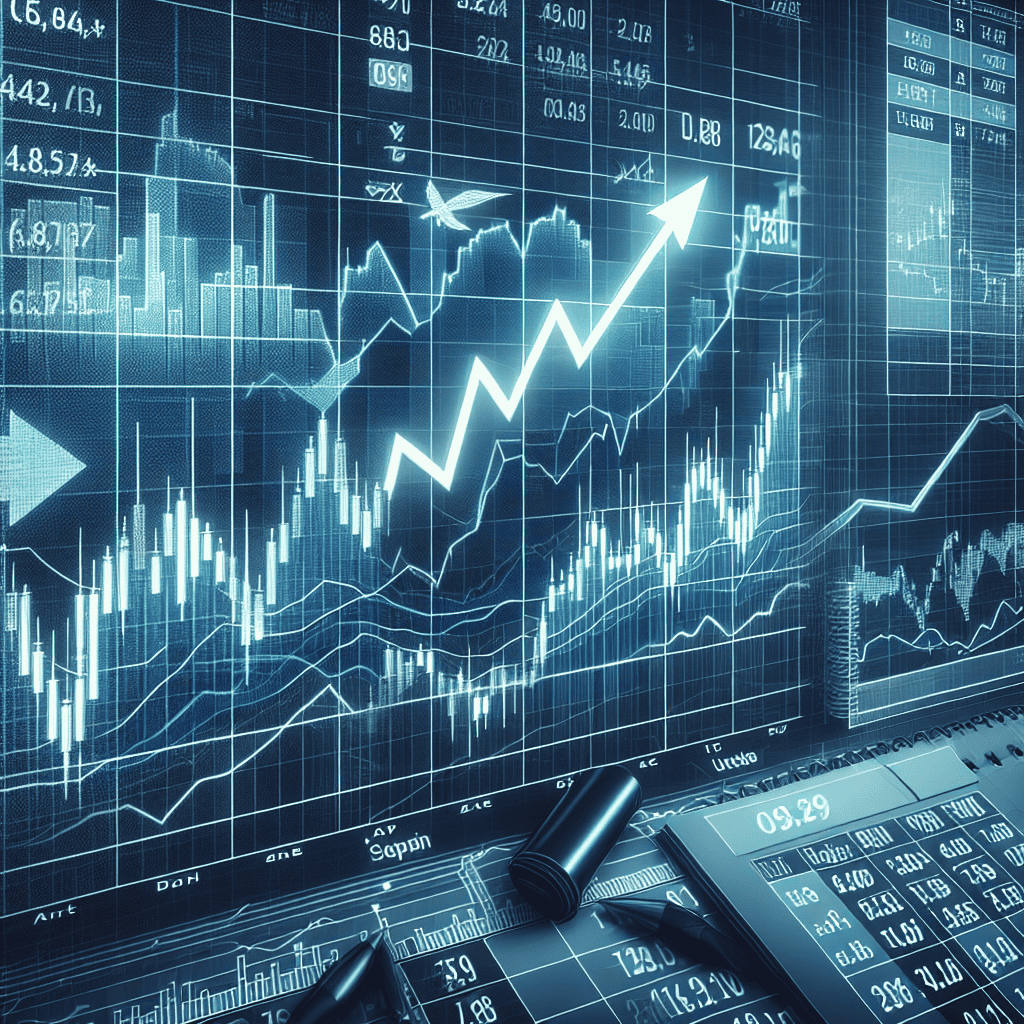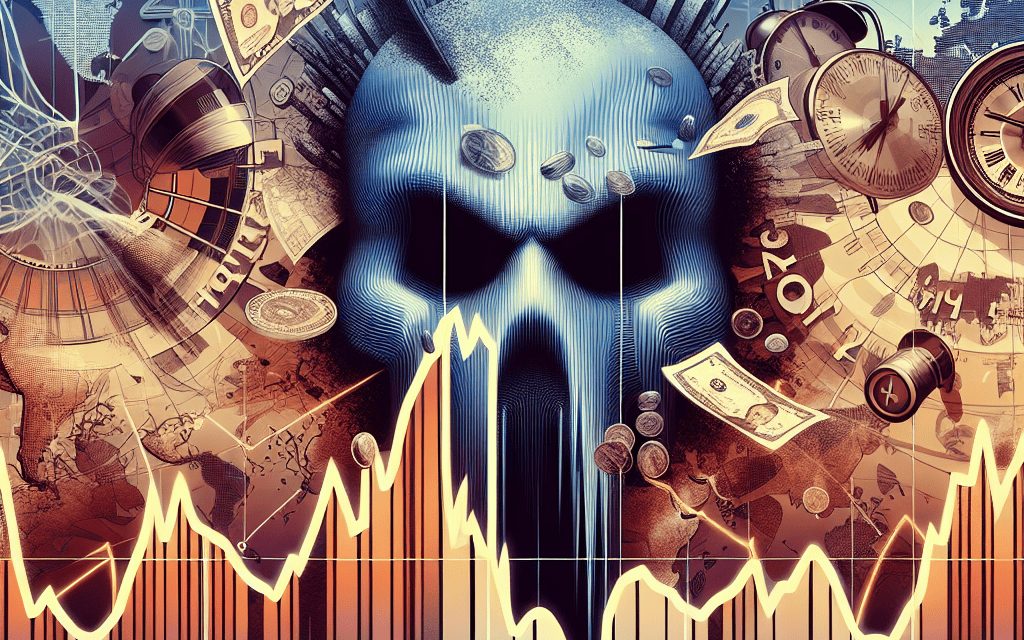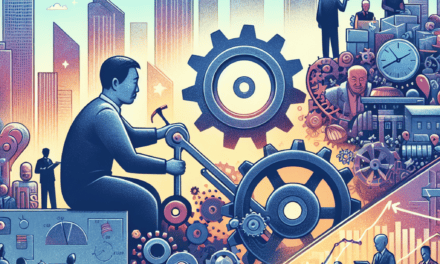“Brace for Impact: Navigating Market Waves Amid US Election and Fed Decisions”
Introduction
As the United States approaches a pivotal period marked by the upcoming presidential election and a crucial Federal Reserve meeting, financial markets are bracing for significant volatility and potential shifts. Historically, such events have been catalysts for market movements, as investors and analysts attempt to gauge the implications of political and monetary policy changes on economic growth, interest rates, and fiscal stability. The election outcome could influence sectors differently, depending on the policy priorities of the winning administration, while the Fed’s decisions on interest rates and monetary policy will be closely scrutinized for signals on inflation control and economic support. Together, these events create a complex landscape for market participants, who must navigate uncertainty and adjust their strategies in anticipation of potential impacts on equities, bonds, currencies, and commodities.
Impact Of US Election On Stock Market Volatility
As the United States approaches a pivotal period marked by the upcoming presidential election and a crucial Federal Reserve meeting, investors and market analysts are bracing for significant market movements. Historically, the intersection of political events and monetary policy decisions has been a catalyst for stock market volatility, and this year is expected to be no different. The anticipation surrounding these events is palpable, as they hold the potential to reshape economic policies and influence investor sentiment.
The presidential election, a cornerstone of American democracy, invariably brings with it a degree of uncertainty that can unsettle financial markets. Investors are keenly aware that different administrations can lead to shifts in fiscal policy, regulatory environments, and international trade relations. Consequently, the stock market often experiences heightened volatility in the months leading up to an election, as market participants attempt to gauge the potential outcomes and adjust their portfolios accordingly. This year, the stakes are particularly high, given the current economic climate and the pressing issues at the forefront of the political discourse.
In tandem with the election, the Federal Reserve’s upcoming meeting is another focal point for market participants. The Fed’s decisions on interest rates and monetary policy are critical in shaping the economic landscape, influencing everything from consumer spending to corporate investment. As the central bank navigates the challenges of inflationary pressures and economic growth, its policy stance will be closely scrutinized. Investors are eager to discern whether the Fed will maintain its current trajectory or signal a shift in its approach, which could have far-reaching implications for asset prices.
The confluence of these two events creates a complex environment for investors, who must weigh the potential impacts on various sectors and asset classes. For instance, sectors such as healthcare, energy, and technology could experience significant fluctuations based on the election’s outcome and subsequent policy changes. Similarly, interest rate-sensitive sectors like real estate and utilities may react sharply to any adjustments in the Fed’s monetary policy. As a result, market participants are likely to adopt a cautious approach, seeking to hedge against potential risks while remaining poised to capitalize on emerging opportunities.
Moreover, the global nature of financial markets means that the repercussions of these events will not be confined to the United States alone. International investors are also attuned to the developments, as changes in US policy can reverberate across global markets. The interconnectedness of economies underscores the importance of these events, as they have the potential to influence global trade dynamics, currency valuations, and cross-border investment flows.
In light of these considerations, it is imperative for investors to remain vigilant and informed as the election and Fed meeting draw near. By closely monitoring political developments and economic indicators, market participants can better navigate the anticipated volatility and position themselves strategically. While uncertainty is an inherent aspect of investing, understanding the potential implications of these major events can provide a measure of clarity and confidence in decision-making.
In conclusion, the approaching US presidential election and Federal Reserve meeting are poised to be significant drivers of market volatility. As investors grapple with the uncertainty surrounding these events, their ability to adapt and respond to changing conditions will be crucial. By maintaining a keen awareness of the evolving landscape, market participants can better manage risks and seize opportunities in this dynamic environment.
Federal Reserve’s Role In Shaping Economic Expectations
As the United States approaches a pivotal period marked by the upcoming presidential election and a crucial Federal Reserve meeting, market participants are bracing for significant movements that could reshape economic expectations. The Federal Reserve, as the central bank of the United States, plays a critical role in influencing economic stability and growth through its monetary policy decisions. With the dual events on the horizon, the Fed’s actions and communications are under intense scrutiny, as they are expected to provide crucial signals about the future trajectory of the economy.
The Federal Reserve’s primary tools for shaping economic expectations include setting interest rates, conducting open market operations, and providing forward guidance. These mechanisms are designed to manage inflation, maximize employment, and stabilize financial markets. As the election draws near, the Fed’s decisions are likely to be influenced by the political climate, economic data, and global economic conditions. The interplay between these factors can create a complex environment for policymakers, who must balance short-term economic needs with long-term objectives.
In the context of the upcoming election, the Federal Reserve’s role becomes even more pronounced. Historically, elections can introduce a degree of uncertainty into financial markets, as investors attempt to anticipate the potential economic policies of the incoming administration. This uncertainty can lead to increased volatility, as market participants adjust their portfolios in response to perceived risks and opportunities. The Fed, therefore, must carefully calibrate its communications to avoid exacerbating market fluctuations while maintaining its independence from political pressures.
Moreover, the Federal Reserve meeting scheduled around the same time as the election adds another layer of complexity. The central bank’s assessment of the economic landscape, as well as its projections for growth, inflation, and employment, will be closely watched by investors and analysts alike. Any changes in interest rates or adjustments to the Fed’s asset purchase programs could have far-reaching implications for financial markets. Consequently, the Fed’s ability to effectively communicate its policy intentions will be crucial in managing market expectations and ensuring a smooth transition through this period of heightened uncertainty.
In addition to domestic considerations, the Federal Reserve must also remain attuned to global economic developments. The interconnectedness of the global economy means that events in other major economies can have significant spillover effects on the United States. For instance, shifts in monetary policy by other central banks, geopolitical tensions, or changes in trade dynamics can all influence the Fed’s decision-making process. As such, the central bank’s role in shaping economic expectations extends beyond national borders, requiring a comprehensive understanding of international economic trends.
In conclusion, as the United States approaches a critical juncture with the impending election and Federal Reserve meeting, the central bank’s role in shaping economic expectations is more vital than ever. Through its monetary policy tools and strategic communications, the Fed has the capacity to influence market sentiment and guide the economy through uncertain times. By carefully navigating the challenges posed by domestic and global factors, the Federal Reserve can help ensure economic stability and foster confidence among market participants. As these events unfold, all eyes will be on the Fed to see how it balances its objectives and steers the economy toward a sustainable path.
Historical Trends: Market Reactions To Election Outcomes
As the United States approaches another pivotal election cycle, investors and market analysts are keenly observing historical trends to anticipate potential market movements. Historically, U.S. elections have been significant catalysts for market volatility, with outcomes often influencing investor sentiment and economic policy directions. The interplay between political developments and market reactions is complex, yet certain patterns have emerged over time, providing valuable insights for stakeholders.
Traditionally, markets have exhibited heightened volatility in the months leading up to an election. This is largely due to the uncertainty surrounding potential policy changes that could impact various sectors. For instance, different administrations may prioritize distinct economic policies, such as tax reforms, regulatory adjustments, or fiscal spending initiatives, each of which can have profound implications for market dynamics. Consequently, investors often adjust their portfolios in anticipation of these shifts, leading to increased trading activity and price fluctuations.
Moreover, the historical data suggests that markets tend to favor incumbency, as continuity in leadership is perceived to offer stability and predictability. When an incumbent party is expected to retain power, markets often react positively, reflecting a sense of reassurance among investors. Conversely, the prospect of a new administration can introduce uncertainty, prompting cautious behavior in the financial markets. This pattern underscores the importance of political stability in fostering investor confidence.
In addition to the election itself, the Federal Reserve’s monetary policy decisions play a crucial role in shaping market reactions. The timing of the upcoming Fed meeting, coinciding with the election period, adds another layer of complexity to the market landscape. Historically, the Fed’s actions, particularly regarding interest rates, have had significant implications for market performance. For instance, a decision to raise interest rates could signal confidence in economic growth, potentially boosting market sentiment. On the other hand, maintaining or lowering rates might be interpreted as a response to economic uncertainties, influencing investor strategies accordingly.
The intersection of these two major events—the U.S. election and the Fed meeting—creates a unique environment for market participants. Investors are likely to scrutinize policy statements and economic indicators closely, seeking clues about future economic trajectories. This heightened attention to detail can amplify market reactions, as even minor developments may be perceived as harbingers of broader trends.
Furthermore, it is essential to consider the global context in which these events are unfolding. In an increasingly interconnected world, international factors such as trade relations, geopolitical tensions, and global economic conditions can also influence market behavior. For example, shifts in U.S. trade policies following an election could have ripple effects across global markets, affecting everything from currency valuations to commodity prices.
In conclusion, the upcoming U.S. election and Federal Reserve meeting are poised to be significant drivers of market activity. By examining historical trends, investors can gain a better understanding of potential market reactions and adjust their strategies accordingly. While the future remains inherently uncertain, the lessons of the past provide a valuable framework for navigating the complexities of the present. As these events unfold, market participants will undoubtedly remain vigilant, ready to respond to the evolving landscape with agility and foresight.
Interest Rate Speculations And Their Market Implications

As the United States approaches a pivotal period marked by the upcoming presidential election and a crucial Federal Reserve meeting, market participants are bracing for significant movements across various financial sectors. The intersection of political and monetary policy events often serves as a catalyst for volatility, and this time is no exception. Investors are particularly focused on interest rate speculations, which are poised to play a central role in shaping market dynamics in the coming months.
The Federal Reserve’s monetary policy decisions have long been a critical factor influencing market behavior. With the economy navigating the complexities of post-pandemic recovery, inflationary pressures, and geopolitical uncertainties, the Fed’s stance on interest rates is under intense scrutiny. Market analysts are divided on whether the central bank will opt to maintain its current rate levels or implement adjustments to address inflation concerns. This uncertainty is fueling speculation and, consequently, market volatility.
In the lead-up to the Fed meeting, investors are closely monitoring economic indicators such as employment data, consumer spending, and inflation rates. These metrics provide valuable insights into the health of the economy and the potential direction of monetary policy. A stronger-than-expected economic performance could prompt the Fed to consider rate hikes to prevent the economy from overheating. Conversely, signs of economic slowdown might lead to a more accommodative stance, with the possibility of rate cuts to stimulate growth.
The implications of interest rate changes extend beyond the immediate financial markets. For instance, higher interest rates typically lead to a stronger US dollar, which can impact international trade by making American exports more expensive and imports cheaper. This dynamic can have ripple effects on global markets, influencing everything from commodity prices to emerging market currencies. Additionally, changes in interest rates affect borrowing costs for consumers and businesses, potentially altering spending and investment patterns.
As the election draws nearer, political developments add another layer of complexity to the market landscape. The outcome of the election could significantly influence fiscal policy, regulatory frameworks, and international relations, all of which have direct and indirect effects on market conditions. Investors are keenly aware that different administrations may prioritize distinct economic policies, which could either complement or counteract the Fed’s monetary policy objectives.
In this context, market participants are employing a range of strategies to navigate the anticipated volatility. Some are adopting a cautious approach, opting for safe-haven assets such as gold and government bonds to hedge against potential market downturns. Others are seeking opportunities in sectors that may benefit from specific policy outcomes, such as renewable energy or infrastructure, depending on the political landscape.
In conclusion, the convergence of the US election and the Federal Reserve meeting presents a unique set of challenges and opportunities for investors. Interest rate speculations are at the forefront of market considerations, with potential implications for currency valuations, trade dynamics, and investment strategies. As these events unfold, market participants will need to remain vigilant, adapting their approaches to align with the evolving economic and political environment. The coming months promise to be a period of heightened activity and strategic decision-making, underscoring the intricate interplay between monetary policy and market forces.
Investor Sentiment: Navigating Political And Economic Uncertainty
As the United States approaches a pivotal period marked by the upcoming presidential election and a crucial Federal Reserve meeting, investor sentiment is poised to navigate a landscape fraught with political and economic uncertainty. Historically, such events have been catalysts for significant market movements, and this year is expected to be no different. Investors are keenly aware that the outcomes of these events could have profound implications for financial markets, influencing everything from interest rates to fiscal policy, and ultimately, the broader economic trajectory.
In the lead-up to the election, market participants are closely monitoring the political climate, as the policies proposed by the candidates could shape the economic landscape for years to come. The potential for shifts in tax policy, regulatory frameworks, and government spending priorities are all factors that investors must consider. Moreover, the election’s outcome could influence international relations and trade policies, further adding layers of complexity to investment strategies. As a result, many investors are adopting a cautious approach, seeking to hedge against potential volatility while remaining agile enough to capitalize on emerging opportunities.
Simultaneously, the Federal Reserve’s upcoming meeting is another focal point for investors. The central bank’s decisions regarding interest rates and monetary policy are critical in shaping economic conditions. With inflationary pressures persisting and economic growth showing signs of fluctuation, the Fed’s stance will be scrutinized for indications of how it plans to balance these competing forces. Investors are particularly interested in any signals regarding the future path of interest rates, as these will directly impact borrowing costs, consumer spending, and corporate investment decisions.
The interplay between the election and the Fed meeting adds an additional layer of complexity to the investment landscape. The Fed’s actions could be influenced by the political environment, while the election’s outcome could, in turn, affect the Fed’s future policy decisions. This dynamic creates a feedback loop that investors must carefully navigate. In this context, market participants are increasingly relying on data-driven insights and sophisticated analytical tools to inform their strategies. By leveraging technology, investors can better assess risk, identify trends, and make informed decisions in an environment characterized by uncertainty.
Furthermore, the global nature of financial markets means that developments in the United States will have ripple effects across the world. International investors are closely watching these events, as changes in U.S. policy can influence global trade, investment flows, and economic growth. Consequently, the interconnectedness of markets necessitates a comprehensive approach to investment strategy, one that considers both domestic and international factors.
In conclusion, as the U.S. election and Federal Reserve meeting draw near, investors are bracing for potential market turbulence. The confluence of political and economic uncertainty presents both challenges and opportunities. By staying informed and adopting a strategic approach, investors can navigate this complex environment, positioning themselves to respond effectively to whatever outcomes may arise. As always, the key to success lies in balancing risk with reward, maintaining a long-term perspective, and remaining adaptable in the face of change.
Sectoral Shifts: Winners And Losers In Election Year Markets
As the United States approaches a pivotal election year, investors and market analysts are closely monitoring the potential sectoral shifts that could arise from the dual impact of the election and the Federal Reserve’s upcoming meeting. Historically, election years have been characterized by heightened market volatility, as investors attempt to anticipate the policy changes that may accompany a new administration. This year, the stakes are particularly high, given the current economic climate and the Federal Reserve’s ongoing efforts to manage inflation and economic growth.
In the lead-up to the election, certain sectors are poised to benefit from the potential policy shifts that could emerge. For instance, the renewable energy sector often garners increased attention during election years, especially when candidates emphasize environmental policies and sustainable energy initiatives. Companies involved in solar, wind, and other renewable technologies may experience a surge in investor interest, driven by the prospect of favorable regulatory changes and government incentives. Conversely, traditional energy sectors, such as oil and gas, may face headwinds if the political discourse leans towards stricter environmental regulations.
Moreover, the healthcare sector is another area where significant shifts could occur. Election years frequently bring healthcare policy to the forefront, with debates surrounding issues such as drug pricing, insurance coverage, and healthcare access. Depending on the election outcome, pharmaceutical companies and healthcare providers could either benefit from deregulation and increased market opportunities or face challenges from potential reforms aimed at reducing costs and expanding access.
In addition to the election, the Federal Reserve’s upcoming meeting is a critical event that could influence market dynamics. The Fed’s decisions on interest rates and monetary policy are closely watched by investors, as they have far-reaching implications for various sectors. For instance, financial institutions, including banks and insurance companies, are particularly sensitive to interest rate changes. A decision to raise rates could bolster bank profits through higher net interest margins, while a rate cut might pressure their earnings.
Furthermore, the technology sector, which has been a significant driver of market growth in recent years, may also be impacted by the Fed’s actions. Higher interest rates could increase borrowing costs for tech companies, potentially slowing down their expansion plans. However, if the Fed signals a commitment to maintaining a supportive monetary environment, tech stocks could continue to thrive, buoyed by investor confidence in their growth prospects.
As these events unfold, investors are advised to remain vigilant and consider diversifying their portfolios to mitigate potential risks. While certain sectors may emerge as clear winners or losers, the interconnected nature of the global economy means that unexpected developments could influence market outcomes. Therefore, maintaining a balanced approach and staying informed about policy changes and economic indicators will be crucial for navigating the complexities of an election year market.
In conclusion, the approaching US election and Federal Reserve meeting present a unique set of challenges and opportunities for investors. By understanding the potential sectoral shifts and remaining attuned to policy developments, market participants can better position themselves to capitalize on the evolving landscape. As history has shown, election years can be unpredictable, but they also offer the potential for significant market movements that can redefine the investment landscape.
Currency Fluctuations: Dollar Dynamics Amid Political Events
As the United States approaches a pivotal period marked by the upcoming presidential election and a crucial Federal Reserve meeting, financial markets are bracing for significant fluctuations, particularly in the currency sector. The U.S. dollar, a cornerstone of global trade and finance, is poised to experience dynamic shifts as investors and policymakers navigate the uncertainties inherent in these major events. Historically, political events such as elections have had profound impacts on currency markets, often leading to heightened volatility. This year is no exception, with the stakes particularly high given the current economic climate. The election outcome could influence fiscal policies, trade agreements, and international relations, all of which are critical factors in determining the dollar’s strength.
Simultaneously, the Federal Reserve’s upcoming meeting adds another layer of complexity to the currency landscape. The Fed’s monetary policy decisions, including interest rate adjustments and quantitative easing measures, are closely watched by market participants. Any indication of a shift in policy could trigger immediate reactions in the currency markets. For instance, a decision to raise interest rates might bolster the dollar as higher rates typically attract foreign investment, increasing demand for the currency. Conversely, a dovish stance could weaken the dollar, as lower rates might deter investment and encourage capital outflows.
Moreover, the interplay between these two events cannot be overlooked. The election results could influence the Fed’s policy direction, as the new administration’s economic priorities may necessitate adjustments in monetary policy. This interconnectedness underscores the complexity of predicting currency movements during such a tumultuous period. Investors, therefore, must remain vigilant, closely monitoring both political developments and central bank communications to make informed decisions.
In addition to domestic factors, global economic conditions also play a crucial role in shaping the dollar’s trajectory. The ongoing recovery from the COVID-19 pandemic, coupled with geopolitical tensions and trade negotiations, adds further uncertainty to the mix. For instance, the strength of other major currencies, such as the euro and the yen, can impact the dollar’s relative value. A robust European recovery or a shift in Japanese monetary policy could alter the balance of currency power, influencing the dollar’s position in the global market.
Furthermore, market sentiment and investor behavior are critical components in this equation. During periods of uncertainty, investors often seek safe-haven assets, which traditionally include the U.S. dollar. However, if confidence in the U.S. political or economic landscape wanes, this could lead to a reevaluation of the dollar’s safe-haven status, prompting shifts towards other assets such as gold or cryptocurrencies.
In conclusion, as the U.S. election and Federal Reserve meeting draw near, the currency markets are on high alert, anticipating potential volatility in the dollar’s value. The intricate interplay of political outcomes, monetary policy decisions, and global economic conditions creates a complex environment for investors. Navigating this landscape requires a keen understanding of both domestic and international factors, as well as an ability to adapt to rapidly changing circumstances. As such, market participants must remain agile, leveraging insights and analysis to manage risks and capitalize on opportunities in this dynamic period.
Q&A
1. **How might the US election impact stock markets?**
– Stock markets may experience increased volatility as investors react to potential policy changes and uncertainty surrounding election outcomes.
2. **What sectors could be most affected by the election results?**
– Sectors such as healthcare, energy, and technology could see significant impacts depending on the policies proposed by the winning candidates.
3. **How does the Federal Reserve meeting influence market movements?**
– The Fed meeting can influence markets through interest rate decisions, economic forecasts, and monetary policy guidance, affecting investor sentiment and asset prices.
4. **What are investors expecting from the Fed regarding interest rates?**
– Investors may anticipate either a rate hike, cut, or pause, depending on current economic conditions and inflation data, which can lead to market adjustments.
5. **How could bond markets react to the election and Fed meeting?**
– Bond markets might see fluctuations in yields based on fiscal policy expectations from the election and interest rate decisions from the Fed.
6. **What role does economic data play in market movements during this period?**
– Economic data releases, such as employment and inflation reports, can influence market expectations and reactions to both the election and Fed meeting outcomes.
7. **How should investors prepare for potential market volatility?**
– Investors might consider diversifying portfolios, hedging risks, and staying informed about political and economic developments to navigate potential volatility.
Conclusion
As the US election and Federal Reserve meeting approach, major market movements are anticipated due to heightened uncertainty and potential policy shifts. Historically, elections can lead to volatility as investors react to potential changes in fiscal policy, regulatory environments, and international relations. The Fed meeting adds another layer of complexity, as any adjustments in monetary policy, particularly interest rate changes, can significantly impact market sentiment and economic forecasts. Investors may adopt a cautious stance, leading to increased market fluctuations as they assess the implications of political outcomes and monetary policy decisions on economic growth, inflation, and corporate earnings. Overall, the convergence of these events is likely to create a dynamic market environment, with potential for both opportunities and risks.





